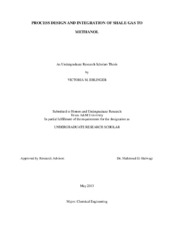| dc.description.abstract | Recent breakthroughs in horizontal drilling and hydraulic fracturing technology have made huge reservoirs of previously untapped shale gas and shale oil formations available for use. These new resources have already made a significant impact on the United States chemical industry and present many opportunities for new capital investments and industry growth. As in conventional natural gas, shale gas contains primarily methane, but some formations contain significant amounts of higher molecular weight hydrocarbons and inorganic gases such as nitrogen and carbon dioxide. These differences present several technical challenges to incorporating shale gas with current infrastructure designed to be used with natural gas. However, each shale presents opportunities to develop novel chemical processes that optimize its composition in order to more efficiently and profitably produce valuable chemical products.
This paper is aimed at process synthesis, analysis, and integration of different processing pathways for the production of methanol from shale gas. The composition of the shale gas feedstock is assumed to come from the Barnett Shale Play located near Fort Worth, Texas, which is currently the most active shale gas play in the US. Process simulation and published data were used to construct a base-case scenario in Aspen Plus. The impact of different processing pathways was analyzed. Key performance indicators were assessed. These include overall process targets for mass and energy, economic performance, and environmental impact. Finally, the impact of several factors (e.g., feedstock composition, design and operating variables) is studied through a sensitivity analysis.
The results show a profitable process above a methanol selling price of approximately $1.50/gal. The sensitivity analysis shows that the ROI depends much more heavily on the selling price of methanol than on the operating costs. Energy integration leads to a savings of $30.1 million per year, or an increase in ROI of 2% points. This also helps offset some of the cost required for the oxygen necessary for syngas generation through partial oxidation. For a sample shale gas composition with high levels of impurities, preprocessing costs require a price differential of $0.73/MMBtu from natural gas. The process is also environmentally desirable because shale gas does not lead to higher GHG emissions than conventional natural gas. More water is required for hydraulic fracturing, but some of these concerns can be abated through conservation techniques and regulation. | en |


